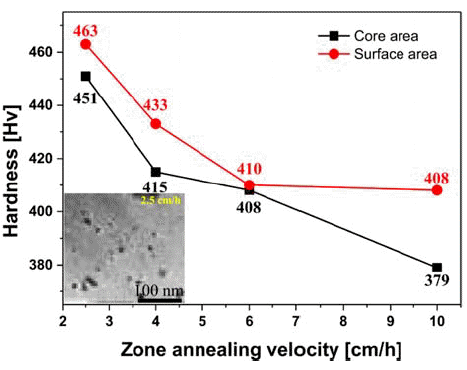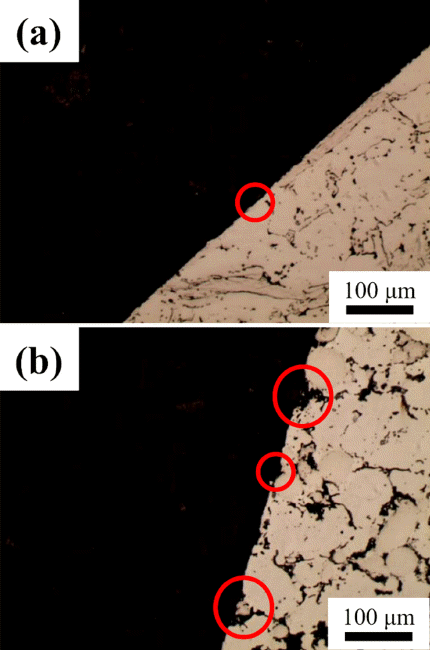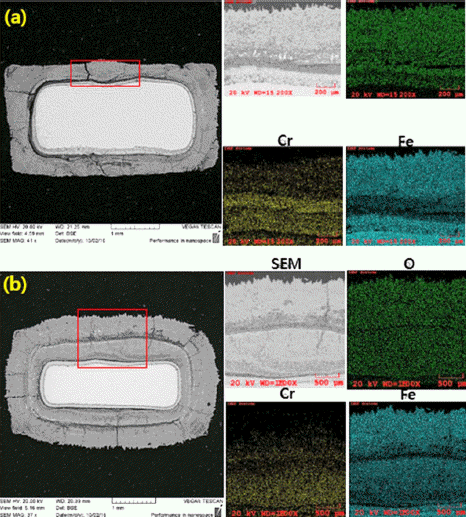Search
- Page Path
- HOME > Search
- [Korean]
- Effect of Zone Annealing Velocity on the directional Recrystallization in a Ni base Oxide Dispersion Strengthened Alloys
- Young-Kyun Kim, Seong-June Yoon, Jong-Kwan Park, Hwi-Jun Kim, Man-Sik Kong, Kee-Ahn Lee
- J Korean Powder Metall Inst. 2018;25(4):331-335. Published online August 1, 2018
- DOI: https://doi.org/10.4150/KPMI.2018.25.4.331

- 455 View
- 2 Download
- 1 Citations
-
 Abstract
Abstract
 PDF
PDF This study investigates the directional recrystallization behavior of Ni based oxide dispersion strengthened (ODS) alloy according to the zone annealing velocity. The zone annealing temperature is set as 1390°C, while the zone velocities are set as 2.5, 4, 6, and 10 cm/h, respectively. The initial microstructure observation of the as-extruded sample shows equiaxed grains of random orientation, with an average grain size of 530 nm. On the other hand, the zone annealed samples show a large deviation in grain size depending on the zone velocities. In particular, grains with a size of several millimeters are observed at 2.5-cm/h zone velocity. It is also found that the preferred orientation varies with the zone annealing velocity. On the basis of these results, this study discusses the role of zone velocities in the directional recrystallization of Ni base ODS alloy.
-
Citations
Citations to this article as recorded by- Directional recrystallisation processing: a review
Chao Yang, Ian Baker
International Materials Reviews.2021; 66(4): 256. CrossRef
- Directional recrystallisation processing: a review
- [Korean]
- Microstructure and Wear Properties of Oxide Dispersion Strengthened Steel Powder Added Steel-Based Composite Material for Automotive Part
- Young-Kyun Kim, Jong-Kwan Park, Kee-Ahn Lee
- J Korean Powder Metall Inst. 2018;25(1):36-42. Published online February 1, 2018
- DOI: https://doi.org/10.4150/KPMI.2018.25.1.36

- 575 View
- 3 Download
- 2 Citations
-
 Abstract
Abstract
 PDF
PDF In order to expand the application of oxide dispersion-strengthened (ODS) steel, a composite material is manufactured by adding mechanically alloyed ODS steel powder to conventional steel and investigated in terms of microstructure and wear properties. For comparison, a commercial automobile part material is also tested. Initial microstructural observations confirm that the composite material with added ODS steel contains i) a pearlitic Fe matrix area and ii) an area with Cr-based carbides and ODS steel particles in the form of a Fe-Fe3C structure. In the commercial material, various hard Co-, Fe-Mo-, and Cr-based particles are present in a pearlitic Fe matrix. Wear testing using the VSR engine simulation wear test confirms that the seatface widths of the composite material with added ODS steel and the commercial material are increased by 24% and 47%, respectively, with wear depths of 0.05 mm and 0.1 mm, respectively. The ODS steel-added composite material shows better wear resistance. Post-wear-testing surface and cross-sectional observations show that particles in the commercial material easily fall off, while the ODS steel-added material has an even, smooth wear surface.
-
Citations
Citations to this article as recorded by- First principles determination of formation of a Cr shell on the interface between Y–Ti–O nanoparticles and a ferritic steel matrix
Ki-Ha Hong, Jae Bok Seol, Jeoung Han Kim
Applied Surface Science.2019; 481: 69. CrossRef - Thermal Properties and Microstructural Changes of Fe-Co System Valve Seat Alloy by High Densification Process
In-Shup Ahn, Dong-Kyu Park, Kwang-Bok Ahn, Seoung-Mok Shin
Journal of Korean Powder Metallurgy Institute.2019; 26(2): 112. CrossRef
- First principles determination of formation of a Cr shell on the interface between Y–Ti–O nanoparticles and a ferritic steel matrix
- [Korean]
- High Temperature Oxidation Behavior of Fe-14Cr Ferritic Oxide Dispersion Strengthened Steels Manufactured by Mechanical Alloying Process
- Young-Kyun Kim, Jong-Kwan Park, Hwi-Jun Kim, Man-Sik Kong, Kee-Ahn Lee
- J Korean Powder Metall Inst. 2017;24(2):133-140. Published online April 1, 2017
- DOI: https://doi.org/10.4150/KPMI.2017.24.2.133

- 421 View
- 3 Download
- 1 Citations
-
 Abstract
Abstract
 PDF
PDF This study investigates the oxidation properties of Fe-14Cr ferritic oxide-dispersion-strengthened (ODS) steel at various high temperatures (900, 1000, and 1100°C for 24 h). The initial microstructure shows that no clear structural change occurs even under high-temperature heat treatment, and the average measured grain size is 0.4 and 1.1 μm for the as-fabricated and heat-treated specimens, respectively. Y–Ti–O nanoclusters 10–50 nm in size are observed. High-temperature oxidation results show that the weight increases by 0.27 and 0.29 mg/cm2 for the asfabricated and heat-treated (900°C) specimens, and by 0.47 and 0.50 mg/cm2 for the as-fabricated and heat-treated (1000°C) specimens, respectively. Further, after 24 h oxidation tests, the weight increases by 56.50 and 100.60 mg/cm2 for the as-fabricated and heat-treated (1100°C) specimens, respectively; the latter increase is approximately 100 times higher than that at 1000°C. Observation of the surface after the oxidation test shows that Cr2O3 is the main oxide on a specimen tested at 1000°C, whereas Fe2O3 and Fe3O4 phases also form on a specimen tested at 1100°C, where the weight increases rapidly. The high-temperature oxidation behavior of Fe-14Cr ODS steel is confirmed to be dominated by changes in the Cr2O3 layer and generation of Fe-based oxides through evaporation.
-
Citations
Citations to this article as recorded by- Microstructure and Wear Properties of Oxide Dispersion Strengthened Steel Powder Added Steel-Based Composite Material for Automotive Part
Young-Kyun Kim, Jong-Kwan Park, Kee-Ahn Lee
journal of Korean Powder Metallurgy Institute.2018; 25(1): 36. CrossRef
- Microstructure and Wear Properties of Oxide Dispersion Strengthened Steel Powder Added Steel-Based Composite Material for Automotive Part
- [Korean]
- Mechanical Properties of Surface Densified PM Gears
- Ki-Jung Kim, Ki-Bum Kim, Doo-Hwan Lee, Jong-Kwan Park, Dong-Guk Jeong
- J Korean Powder Metall Inst. 2012;19(3):189-195.
- DOI: https://doi.org/10.4150/KPMI.2012.19.3.189

- 597 View
- 1 Download
- 1 Citations
-
 Abstract
Abstract
 PDF
PDF - A novel PM (powder metallurgy) steel for automotive power-train gear components was developed to reduce manufacturing cost, while meeting application requirements. The high-density PM steel was manufactured by mixing using special Cr-Mo atomized iron powders, high-pressure compaction, and sintering. Tensile strength, charpy impact, bending fatigue, and contact fatigue tests for the PM steel were carried out and compared to conventional forged steel. Pinion gears for auto-transmission were also manufactured by helical pressing, sintering, and surface densification process. In order to evaluate the durability of the PM parts, auto-transmission durability tests were performed using dynamometer tests. Results showed that the PM steel fulfilled the requirements for pinion gears indicating suitable tensile, bending fatigue, contact fatigue strengths and improved gear tooth profile. The PM gears also showed good performance during the transmission durability tests. As a result, the PM gears showed significant potential to replace the conventional forged steel gears manufactured by tooth machining (hobbing, shaving, and grinding) processes.
-
Citations
Citations to this article as recorded by- Thermal Properties and Microstructural Changes of Fe-Co System Valve Seat Alloy by High Densification Process
In-Shup Ahn, Dong-Kyu Park, Kwang-Bok Ahn, Seoung-Mok Shin
Journal of Korean Powder Metallurgy Institute.2019; 26(2): 112. CrossRef
- Thermal Properties and Microstructural Changes of Fe-Co System Valve Seat Alloy by High Densification Process
TOP
 kpmi
kpmi


 First
First Prev
Prev


